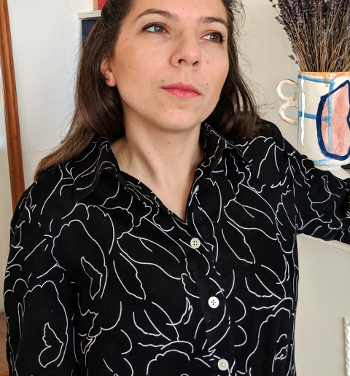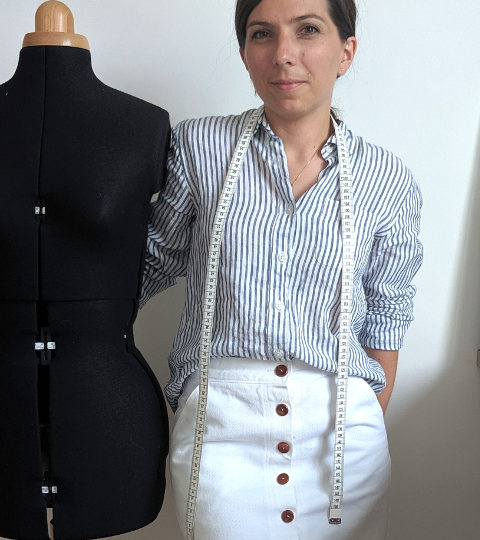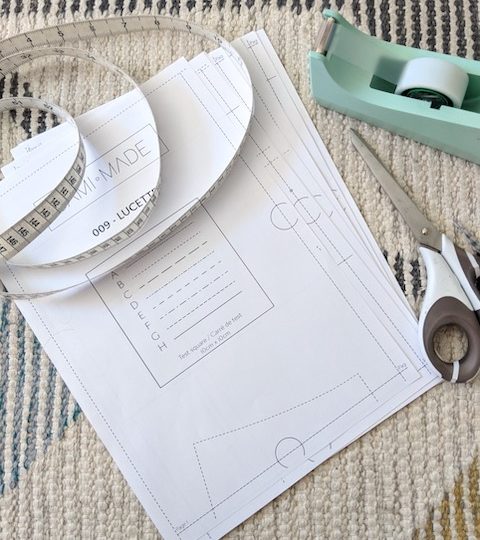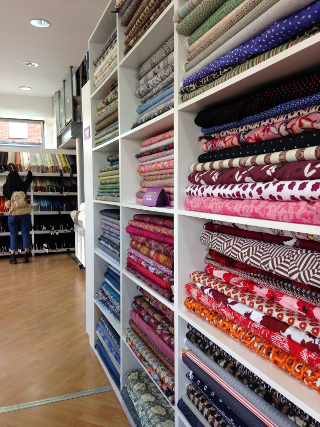Hello everyone! In this article, I give you my tips on how to use a twin needle (or double needle) on your sewing machine. Nothing will stop you from making beautiful hems on your knit fabrics anymore.
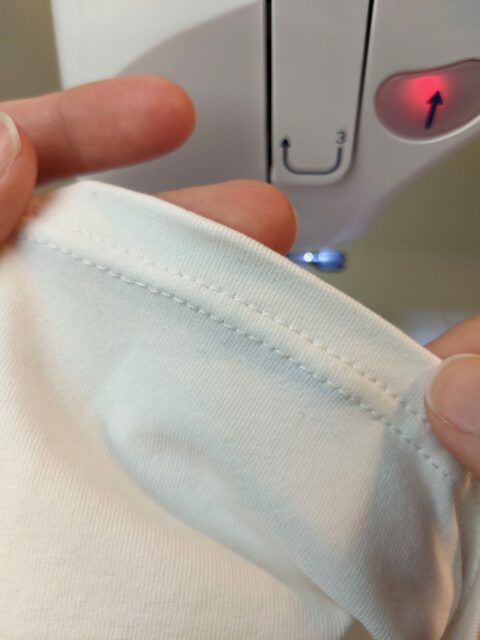
What does a twin needle do?
Before explaining how to use a twin needle, let’s talk about what it does. The seam made with a twin needle gives us two parallel lines of stitches on the right side, and a line in zigzag on the wrong side.
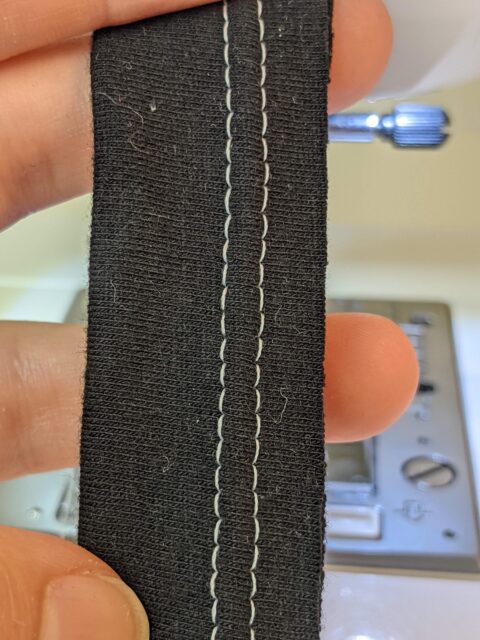
Double needle stitching – right side
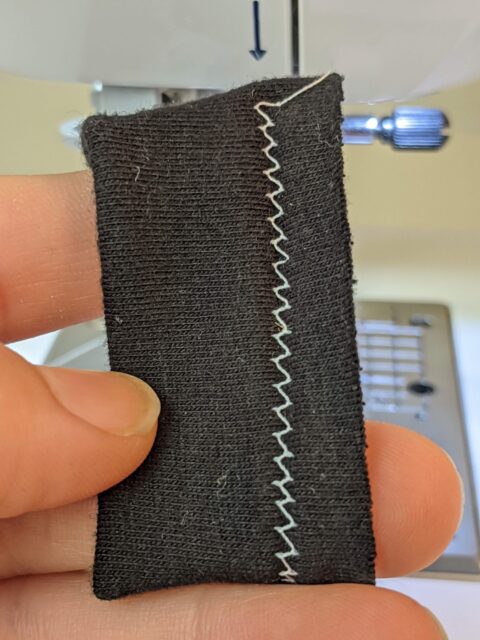
Double needle stitching – wrong side
The particularity of this stitch is that it stretches, therefore it is very useful for knit fabrics such as jersey.
I mainly use it for hemming jersey tops. I actually recommend it for hemming my Nuage and Vague patterns.
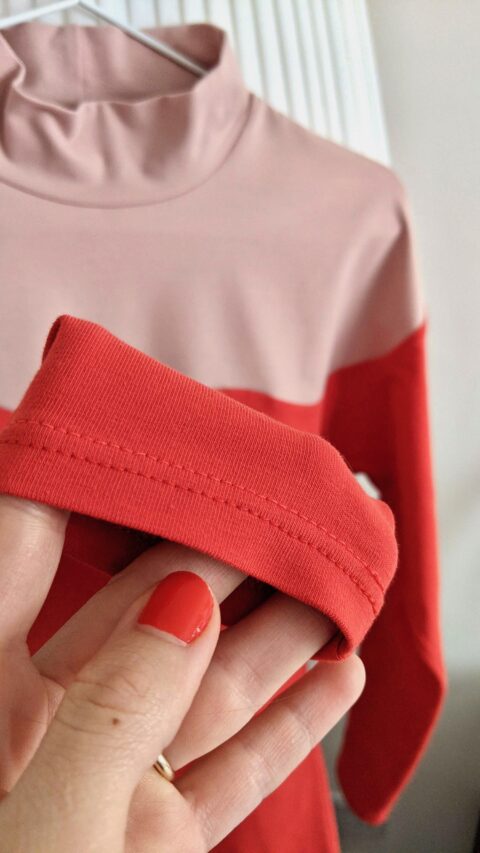
Sleeve hem made using a double needle on the Vague pattern
The twin needle stitching mimics the professional finishes that you can see on ready-to-wear t-shirts or other jersey tops, normally made with a coverstitch machine. But personally I don’t have a coverstitch machine, partly because I lack of space. But above all, it’s not an investment that I want to make, since the double needle does the job very well!
Which double / twin needle to choose?
As with single needles, there are many different twin needles. Here is what sets them apart, apart from the brand:
- The type of needle: “stretch”, “ball point” for stretch fabrics, “universal” for woven fabrics.
- The gap between the two needles: between 1.60 mm and 6.00 mm (“extra wide”) depending on the needles. Choose according to your aesthetic preference. Take a look at the t-shirts in your wardrobe and make up your mind. Personally I swear by my double needle with a 4 mm gap!
- The thickness of the needles: between 70 and 100. It is exactly like for the single needles, use the finest (70) for the thinnest fabrics, the thickest for the thickest fabrics (100 – you can use these for topstitching on denim). I would say the average size is 80.
I only have one double needle, and it is suitable for most of my hemming work on jersey: I use a stretch type twin needle, 4.00 mm apart, and 75 thick.
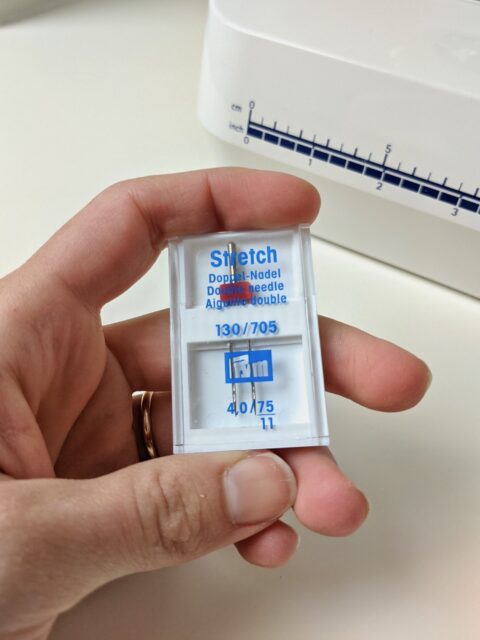
How to use a twin needle?
Now that you know how to chose a twin needle, here are my tips on how to use it.
How to change needle?
With your machine turned off, loosen the screw to the right of the needle, then remove the needle. Install the twin needle in place, with the flat part of the head towards the back of the machine, and tighten the screw.
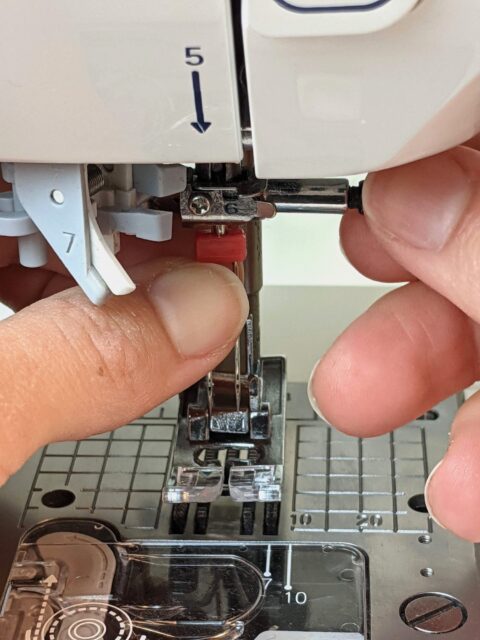
How to thread the double needle
To sew with the twin needle, you need two spools of thread and a case bobbin.
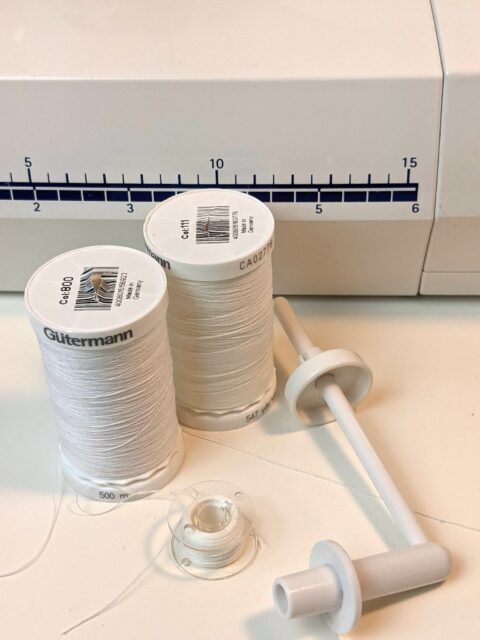
Add a 2nd spool holder on top of your machine. This is normally supplied with your machine and there should be a space dedicated to it on your machine.
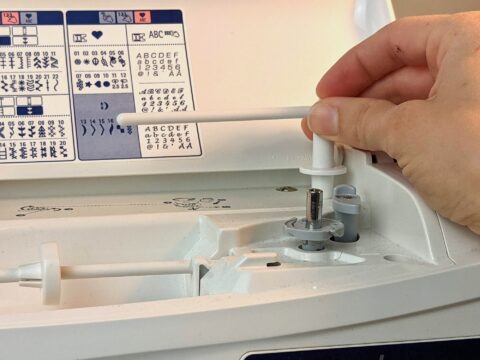
Install your spools with their respective spool cap (the small object that keeps the spool in place). Make sure that the spools unwind correctly, by pulling on the threads.
Thread the first spool in the usual way into the left needle. Then thread the second spool in the usual way until the last thread guide, in which you will not pass the thread. Instead, thread it straight into the right needle. This allows the two threads not to tangle while sewing.

What settings for the twin needle?
With a double needle, we work in straight stitch.
I recommend a stitch length of 3 mm for the hems. This is a personal preference, test several lengths to make up your mind.

Some machines have a special setting for twin needle (this is the case with my JUKI HZL-F300). Pull out the manual for your machine to find out more!
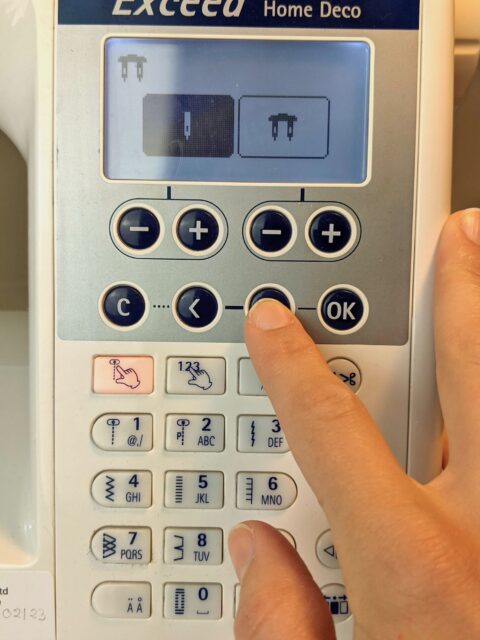
Test the tension of the upper threads, as this influences the result. It is best to do a test on a sample of fabric before you start your final seam.
When the tension is too strong, the two lines of stitching create a small bump on the right side.

When the tension is too low, the two upper threads are too loose and therefore the bobbin thread hardly zigzags. The seam looses its elasticity.

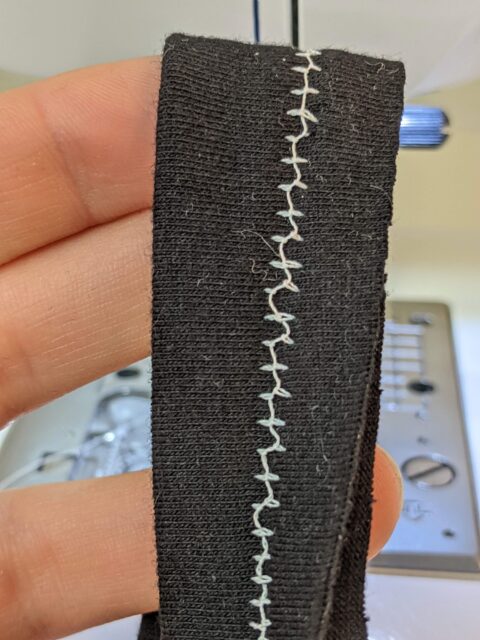
With a medium tension, the result is more satisfactory on the front and on the back.
How to hem with a twin needle
A twin needle hem finishes a t-shirt or other jersey top in an almost professional way.
I have published a short video to show you how I hem on jersey on instagram, and for more details, read the rest of the article:
Prepare your hem (I like 1.5 – 2 cm / 3/8” – 3/4” hems) by pressing it to the wrong side. Personally, I also like to finish the raw edges with the overlocker before making my hems with the double needle.
Sew the hem with the right side of the garment towards you, positioning the fold of the fabric at 1.2 cm* for a 1.5 cm hem (1.7 cm for a 2 cm hem). * Compared to the marking on the needle plate.
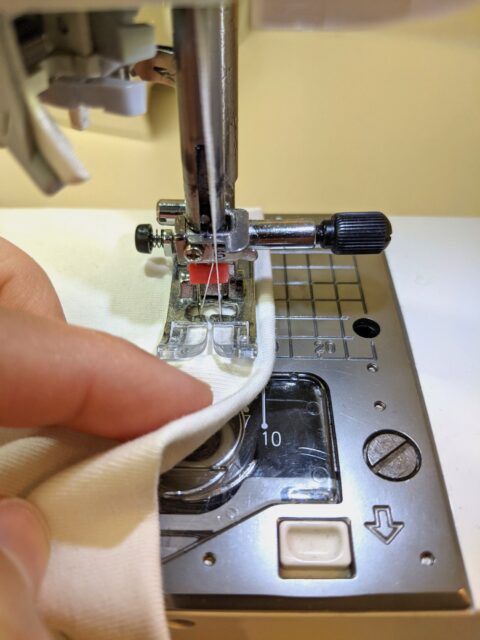


I like to overlock my raw edge before using my twin needle, but you can still notice the zigzaging thread on the wrong side.
Do not backstitch to start or backstitch to finish the seam. Go a few stitches over the beginning of the seam when you finish the hem. Pass all the threads to the wrong side, by pulling on the threads located on the wrong side. Then knot them before cutting them.
Finally press your hem to flatten the seam, which can warp a little sometimes.
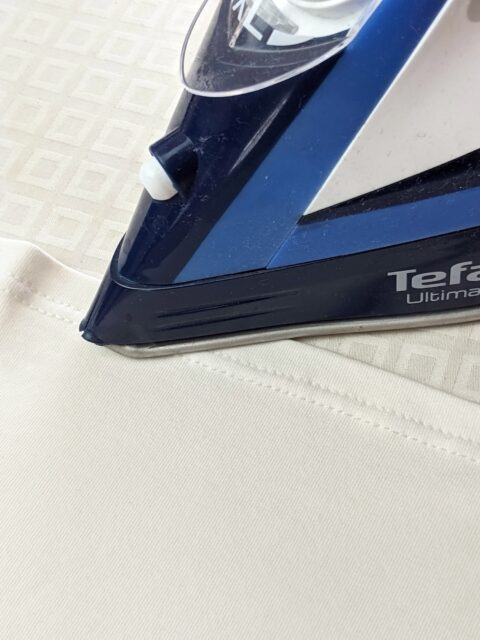
Troubleshooting problems with a twin needle
Here are some problems you may encounter while using a twin needle, and some possible solutions.
- Skipped stitches :
If you still have an issue, slightly lower the thread tension, or reduce your sewing speed, and see what happens.
Another idea: are you using an old twin needle? Change to a new one.
Personally, this often happens to me when my fabric is very thin and very stretch. The fabric is brought down with the pressure of the needle, and stitches are not formed. You probably need to change the twin needle to a finer one.
- The upper threads break easily:
First of all, rethread your threads and see what happens. If you still have an issue, try the solutions from above in the same order: slightly lower the thread tension, reduce sewing speed, change to a new needle, or change to a thinner twin needle.
- The two threads are tangled:
Make sure you are using great quality threads. Be careful not to pass the right thread through the last thread guide to avoid this problem.

- There is a bump between the two lines of stitching:
Adjusting the tension prevents this. Reduce the thread tension. I have noticed that overlocking the raw edge underneath helps with not getting a bump.
If it is only a small bump, a good press might be able to fix it.
- The seam is not very elastic:
This happens when the tension is too low because the bobbin thread does not zigzag and the seam loses its elasticity.
- The fabric has warped after twin needle sewing
The pressure of the presser foot may have something to do with it, lower it slightly. Otherwise, do not panic, a good press will fix this.
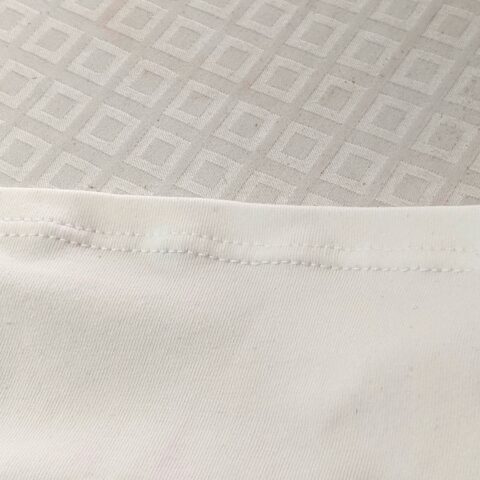
I hope my tips help you understand how to use a twin needle. Do not hesitate to leave me your questions in the comments.
This post is also available in French.


